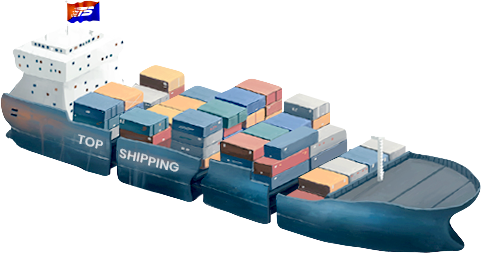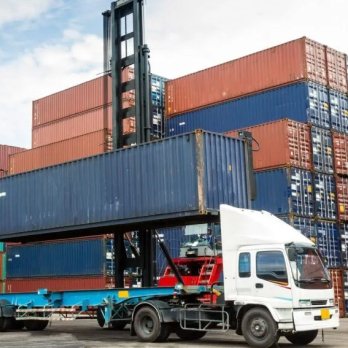

Table of Contents
Results of which goods may weigh the same but take up different space; it cannot be expected then to pay the same charge, can it?
Besides, to further enhance your shipping experience with greater transparency and cost predictability, we proudly provide this convenient, universal chargeable and volumetric weight calculator absolutely free.
This calculator can help you work out the chargeable weight of goods with complete accuracy, considering their actual weight and volume of occupied space.
This freight charge calculator enables you to minimize the chances of unexpected fees charged for shipping your products and provide surety that your logistics budget will sail through with ease.
Our calculator is versatile and caters for a wide range of dimensional factors and volumetric ratios applied by various freight carriers in different modes of shipment and regions.
Whether your cargo travels by air, ocean, or road, and whatever your choice of freight carrier, our calculator offers a reliable way of ascertaining chargeable weight.
It will, therefore, follows that it shall be the best on-hand tool to get through freight shipping complexes and arrive at a harmonious decision that agrees with your financial constraints and logistical imperatives.
How to Calculate Chargeable Weight
Step 1: Input Shipment Volume and Weight
Begin by inputting the shipment volume and weight. You have two options:
In case you know total shipment volume and weight, slide the switch to the right.
If you know the volume and weight per unit, slide the switch to the left. Click ‘Total Volume’ if your shipment consists of boxes of different volumes or weights.
Step 2: Input Dimensional Factor
Enter the dim factor. For most common scenarios, standard dim factors are suitable:
Ocean freight: 1:1000 volume ratio
EU trucking: 1:3000
Express freight/courier: 1:500
Air freight: 1:600
In other, less common cases, provide your own ratio and unit of measurement (UOM), example “194” or “250” and “cu in/lb” for US trucking companies that don’t use freight class. If you choose volume ratio, “1:” will be auto-populated.
Step 3: Determine Chargeable Weight
The chargeable weight is highlighted in green and is the heavier of:
Dim weight (shipment volume divided by dim factor)
Total shipment weight (total weight or unit weight x quantity)
Step 4: For Cylindrical Packages
If you’re dealing with cylindrical packages, follow these additional steps:
Check with the carrier whether they square the circle (the diameter becomes width and height) or use πr².
Multiply that number by the length to get volume.
With this comprehensive guide, henceforth, you can work out the exact chargeable weight for your shipment to ensure transparency and cost predictability in freight shipping.


What are Volumetric & Chargeable Weight?
Volumetric weight and chargeable weight are terms commonly used in the shipping and logistics industry to determine the cost of transporting goods. Here’s what each term means:
Chargeable Weight:
The chargeable weight is the higher value of the actual weight measured in pounds or kilograms of the shipment and volumetric weight determined by a calculated formula.
In other words, it is the weight that carriers use when calculating charges for shipment. If the volumetric weight becomes greater than the actual weight, then the chargeable weight is based on the former. On the other hand, in case the actual weight turns out to be greater, then that will be considered the chargeable weight.
This system ensures that carriers are duly compensated for the space taken up by shipments, either by weight or volume. It curbs the cases where lightweight and bulky items pay much lower shipping charges compared to the space used.
The final list: Volumetric weight is an imaginary weight derived based on package dimensions, while chargeable weight is the weight used for billing based on a comparison between actual weight and volumetric weight.
Both concepts are vital in determining shipping cost, and a reasonable freight transportation pricing would not have been possible without them.
Volumetric Weight:
It is also referred to as volumetric weight and dimensional weight, where the calculation value comes from the package volume and not its physical weight.
It applies when the space taken up by a package in a transport vehicle becomes an important determinant factor in shipping cost. Volumetric weight is helpful to the carriers in accounting for the cost involved in transporting lightweight and bulky items that take a great amount of space but have less weight.
Most times, volumetric weight formulas change with the mode of transportation and carriers that may have their specific policies. This usually involves multiplication of package length, width, and height in appropriate units-inches or centimeters-and dividing by a dimensional factor or volumetric ratio supplied by the carrier.
It is the ratio that would give how many units of volume comprises one unit of weight, either pounds or kilograms, for the purpose of billing.
Volumetric Weight Saves Cost
Volumetric weight is popularly known as dimensional weight, a concept in shipping and logistics industries that allows the charging of shipments based on the occupied space by packages, not by their actual weight. Quite to the contrary of expectations, volumetric weight could save costs for both shippers and carriers in certain cases. How? Read on.
Optimizing Space Utilization:
Volumetric weight incentivizes the shipper to start optimizing the packaging process to get rid of unnecessary empty space.
Irregularly-shaped lightweight items may occupy a lot of space when being shipped, with very little weight added to the package.
When volume is factored in rate calculation, the carriers would, thus, be reasonably compensated for such packages.
This, in turn, motivates shippers toward packaging methods that put the available space to maximum use. This also means spending less on transport activities, hence bringing down the overall cost involved in shipment and delivery.
Fair Pricing for Carriers:
Disregarding computation for volumetric weight may entice carriers to move oversized yet lightweight packages with very minimal shipping charges against the space consumed.
This could translate to probable losses for carriers, particularly in routes whose cargo capacity is quite limited or in high demand.
It takes into consideration the volumetric weight that will ensure the carriers are compensated well enough to handle the various types of shipment, hence guaranteed financial viability and more room for improvement in service provision.
Encouraging Consolidation and Optimization:
Volumetric weight may also, thus, encourage the shipper to combine small packages into larger and, therefore, denser shipments whenever possible.
The packing of several small packages into one large shipment will ensure that fewer packages are processed and shipped as independent entities, which brings about several economies of scale in reducing the overall cost of shipment. This helps in minimizing environmental impacts related to shipping since it minimizes resources used for transportation.
Balancing Pricing Considerations: Volumetric weight is one way carriers balance actual weight with space utilization in arriving at shipping charges.
This ensures that not only lightweight, bulky items but heavy, dense items too get priced fairly based on the impact that each type has on the resources of transportation. By doing so, carriers can offer competitive pricing to cover operational costs and ensure profitability.
Conclusion: Far from being an additional factor in cost considerations, volumetric weight actually optimizes space utilization and ensures that pricing is fair; it encourages consolidation and balances the considerations of pricing in the shipping and logistics industry as a whole.
Volumetric pricing, by promoting efficiency and equity, eventually redounds to a long-term cost savings for shippers and carriers alike.
Volumetric Weight Calculation for Air Freight
Calculating volumetric weight for air freight requires determining a shipment’s dimensional weight, which is derived from the volume occupied by the package, not the actual weight of said package. The formula to calculate volumetric weight depends somewhat on the unit of measurement used and particular requirements of the air carrier. Herein is general guidance to calculate volumetric weight for air freight:
Measure the Package:
Take the length, width, and height of the package in either inches or centimeters. Make sure you get the outer dimensions of the package by measuring over the packaging materials, such as boxes or padding.
Calculate the Volume:
Multiply the length times width times height to obtain the volume of the package. It will be in either cubic inches or cubic centimeters, whichever unit of measurement was used in taking the dimensions.
Convert to the Appropriate Unit:
Convert the volume to the correct unit of measure for the carrier. Some may want it in cubic inches and others in cubic centimeters. Make sure your computation is compatible with what is required by the carrier.
Apply the Volumetric Ratio:
Volumetric ratio or dimensional factor given by carrier – This is the conversion between the volume and weight for billing purposes. It is usually in ratio form, e.g., 1:600, to mean that one unit of volume has the equivalent weight unit, probably pounds or kilograms.
Calculate Volumetric Weight:
To calculate the volumetric weight, one would divide the volume of the package by the volumetric ratio. The resulting figure will be expressed in the same unit of weight as that described in the given volumetric ratio, such as pounds or kilograms.
Here’s the formula for calculating volumetric weight:
To determine the volumetric weight of a package in your sea freight shipment, you can use the following formula:
Volumetric Weight = (Length × Width × Height) / Volumetric Ratio
Once you’ve computed the volumetric weight for each package, compare it to the actual weight.
The greater of the two values becomes the chargeable weight used for billing by the sea carrier.
This practice ensures fair compensation for the space utilized in the shipment, whether attributable to weight or volume factors.
How to Calculate Volumetric Weight for Sea Freight
Calculation of volumetric weight for sea freight-as in air freight-is based on the dimensional weight of a shipment. However, the exact formula and dimensional factors to be used could vary depending on the carrier and the type of sea freight-an example could be a full container load or less than a container load. Here is a general guide on how to calculate volumetric weight for sea freight:
Measure the Package:
Measure the length, width, and height of any package in inches or centimeters. Make sure you are measuring the outer dimensions of the package, including all packaging materials such as boxes or pallets.
Calculate the Volume:
Using the dimensions taken, multiply the length, width, and height together to get the volume of the package in cubic inches or cubic centimeters, depending on the unit of measurement applied.
Convert to the Appropriate Unit:
Convert the volume to the unit of measure that is taken by the carrier. Some use cubic inches, but the majority are using cubic centimeters. Make sure your calculation matches what the carrier uses.
Apply the Volumetric Ratio:
Determine first what volumetric ratio or dimensional factor the carrier applies.
This is the ratio one would use to convert volume into weight for billing purposes.
The usual notation of a ratio is 1:1000 or 1:500. It means one unit of volume equals some unit of weight, such as pounds or kilograms.
Calculate Volumetric Weight:
To calculate volumetric weight, divide the package volume by the volumetric ratio. It will give the unit in the same weight unit that the volumetric ratio specified.
Here’s the formula for calculating volumetric weight:
To determine the volumetric weight of a package in your sea freight shipment, you can use the following formula:
Volumetric Weight = (Length × Width × Height) / Volumetric Ratio
Once you’ve computed the volumetric weight for each package, compare it to the actual weight.
The greater of the two values becomes the chargeable weight used for billing by the sea carrier.
This practice ensures fair compensation for the space utilized in the shipment, whether attributable to weight or volume factors.
Calculation of volumetric weight is thus indispensable in the shipping of freight by air or sea. Volumetric weight, otherwise known as dimensional weight, ensures a very fair pricing policy, since it considers occupancy in space by packages rather than just their actual weight.
The carriers consider not only the weight but also the volume of the shipment to accurately arrive at the chargeable weight-a fact that leads to much transparency and cost predictability in the shipment process.
For air freight, this would be by measurement of the dimensions of the package alone, followed by the conversion of volume into the appropriate unit using the volumetric ratio provided by the carrier and division to obtain the volumetric weight. In this case, sea freight also does this process in the same way, although it could have its volumetric ratios depending on carriers and modes of shipping.
It is, therefore, paramount to understand and correctly calculate the volumetric weight so that both shippers and carriers are rightly priced for space utilization, which, in the long run, will reduce costs in freight transportation.
One can use volumetric weight calculation to make an informed decision that answers to their budget and logistics requirements, be it in shipment or otherwise, in a freight shipping industry that is complex.

TopShipping
With years of experience in logistics and freight forwarding, the author is passionate about making shipping smoother and more efficient.
As a leader at TopShipping, they’ve developed a deep understanding of supply chain management, international shipping rules, and creative logistics solutions. They’re driven by a desire to help businesses succeed by delivering reliable, customer-focused services.
Over the years, they’ve also shared their expertise by writing for various industry publications, offering practical tips and insights on the latest trends in logistics. Thanks to their leadership, TopShipping has become a trusted name for companies looking for hassle-free global freight solutions.
Comment Section
Comment
Write your idea about "Calculate chargeable volumetric weight"















No comments yet.